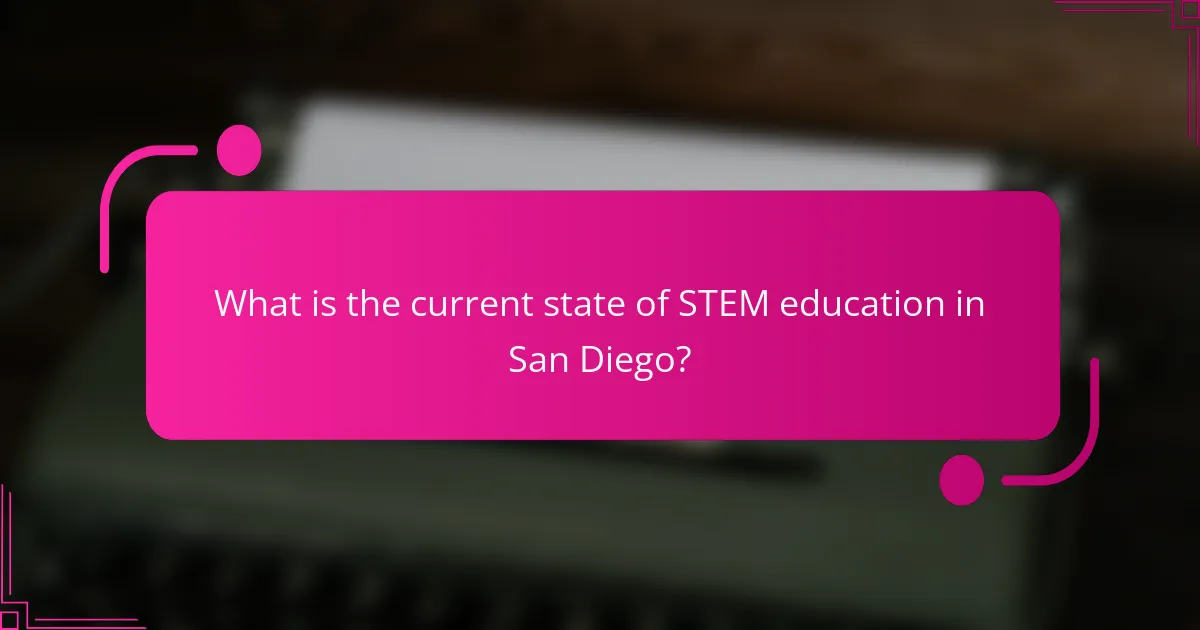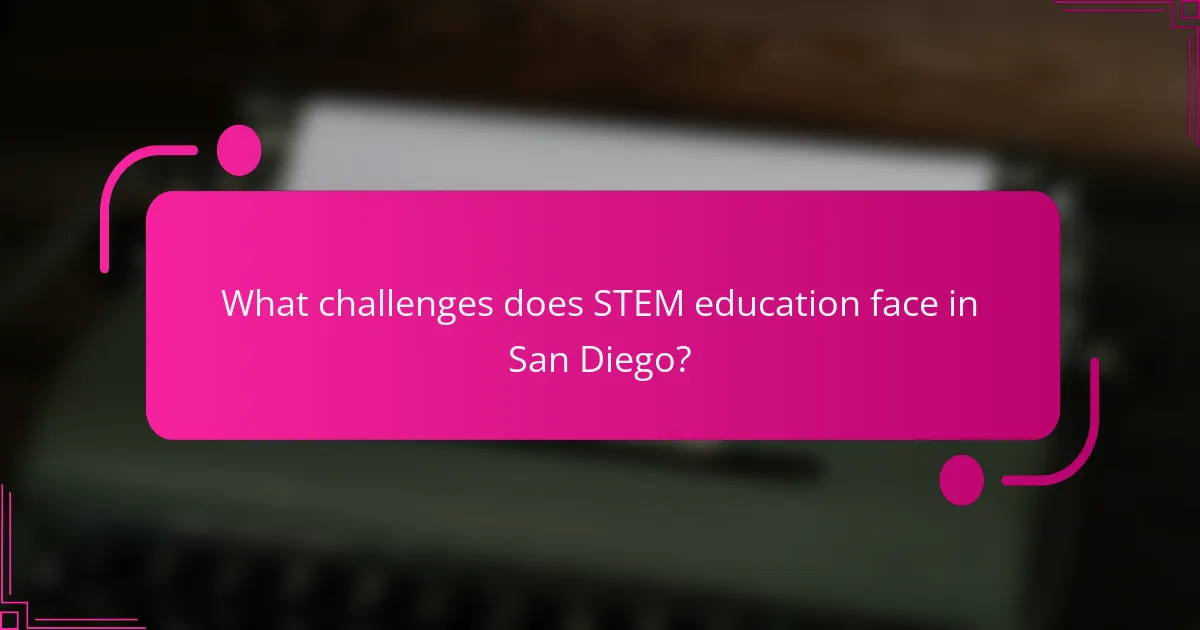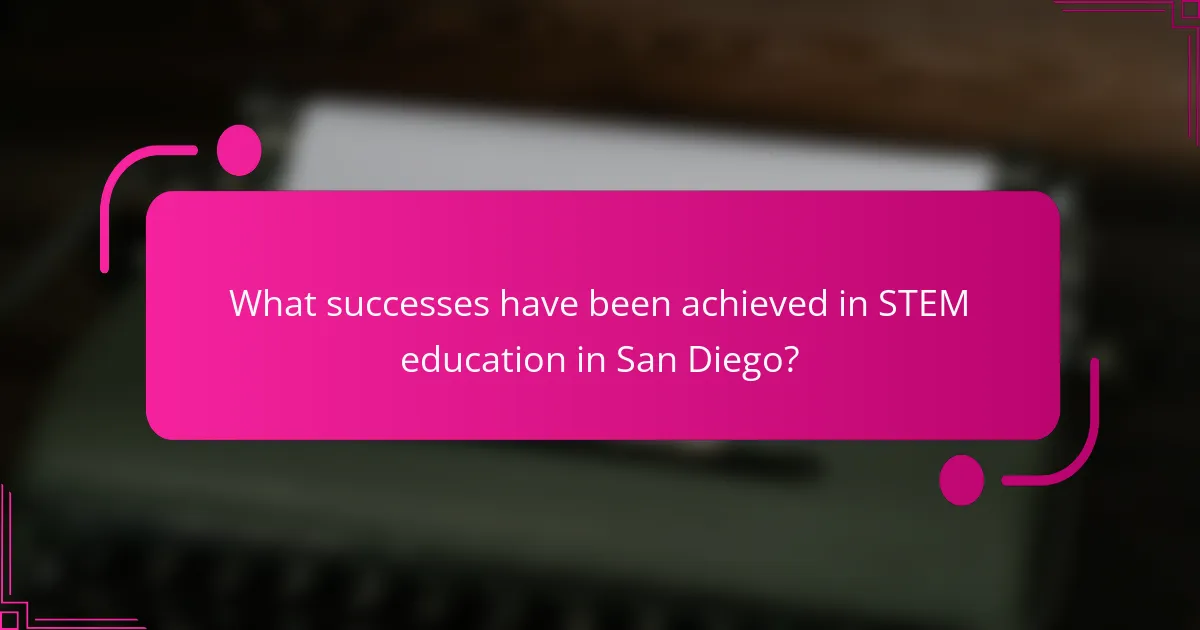
What is the current state of STEM education in San Diego?
STEM education in San Diego is experiencing significant growth and development. Local schools and organizations are increasingly prioritizing STEM curricula. This includes integrating hands-on learning and real-world applications. Programs like the San Diego STEM Ecosystem foster collaboration among educators, businesses, and community leaders. Recent initiatives focus on enhancing access to STEM resources for underrepresented groups. According to the San Diego Unified School District, STEM enrollment has risen by over 15% in the past three years. These efforts aim to prepare students for future careers in technology and science. Overall, San Diego is making strides in creating a robust STEM education landscape.
How does STEM education impact students in San Diego?
STEM education significantly enhances students’ problem-solving skills in San Diego. It fosters critical thinking and creativity among learners. Students engaged in STEM are more likely to pursue careers in technology and engineering fields. According to a report by the San Diego Workforce Partnership, there is a growing demand for STEM professionals in the region. This demand leads to increased job opportunities for students with STEM backgrounds. Additionally, STEM education promotes collaboration through team-based projects. Research shows that students involved in collaborative STEM activities exhibit improved communication skills. Overall, STEM education prepares San Diego students for a competitive job market.
What are the key components of effective STEM education?
The key components of effective STEM education include hands-on learning, interdisciplinary approaches, and real-world applications. Hands-on learning engages students through practical experiences. Interdisciplinary approaches integrate various subjects to enhance understanding. Real-world applications connect classroom knowledge to everyday life. Research indicates that these components improve student engagement and retention. According to a study by the National Academies of Sciences, Engineering, and Medicine, effective STEM education promotes critical thinking and problem-solving skills. These skills are essential for success in the modern workforce.
How does STEM education influence career paths for students?
STEM education significantly influences career paths for students by equipping them with essential skills. It enhances critical thinking, problem-solving, and analytical abilities. These skills are highly sought after in various industries. According to a report by the U.S. Bureau of Labor Statistics, STEM jobs are projected to grow by 8% from 2019 to 2029. This growth rate is faster than the average for all occupations. Additionally, students engaged in STEM education often pursue degrees in engineering, computer science, and healthcare. These fields offer high earning potential and job stability. Furthermore, STEM education fosters innovation and creativity, which are crucial in today’s job market. As a result, students with STEM backgrounds are better prepared for diverse career opportunities.
What initiatives are currently shaping the future of STEM education in San Diego?
Current initiatives shaping the future of STEM education in San Diego include the San Diego STEM Ecosystem, which fosters collaboration among educators, businesses, and community organizations. This initiative aims to enhance STEM curriculum and resources in local schools. Another key initiative is the “STEM for All” program, promoting equitable access to STEM education for underrepresented students. Additionally, partnerships with local universities, such as UC San Diego, provide mentorship and research opportunities for high school students. The “Coding for All” initiative focuses on teaching coding skills to students from diverse backgrounds. These programs collectively aim to improve STEM literacy and career readiness in the region.
Which organizations are leading STEM initiatives in the region?
The organizations leading STEM initiatives in the San Diego region include the San Diego Unified School District, UC San Diego, and the San Diego Science and Technology Council. The San Diego Unified School District implements various STEM programs in K-12 education. UC San Diego offers research opportunities and community outreach in STEM fields. The San Diego Science and Technology Council promotes collaboration among local businesses and educational institutions to enhance STEM education. These organizations contribute significantly to advancing STEM education and workforce development in the region.
What programs are being implemented in local schools?
Local schools in San Diego are implementing various STEM education programs. These programs focus on enhancing science, technology, engineering, and mathematics skills. Notable initiatives include robotics clubs, coding workshops, and hands-on science experiments. Schools are partnering with local organizations to provide resources and training. The aim is to prepare students for future careers in STEM fields. Data shows that participation in these programs increases student engagement and interest in STEM subjects. Research indicates that early exposure to STEM education leads to better academic outcomes.

What challenges does STEM education face in San Diego?
STEM education in San Diego faces several challenges. One major issue is the lack of funding for programs and resources. According to a 2021 report by the San Diego Unified School District, budget constraints hinder the implementation of comprehensive STEM curricula. Additionally, there is a shortage of qualified STEM teachers in the region. A study by the California Commission on Teacher Credentialing indicated that many schools struggle to fill STEM teaching positions. Furthermore, disparities in access to STEM education exist among different demographics. Research from the San Diego Workforce Partnership shows that underrepresented communities often have limited opportunities in STEM fields. These challenges collectively hinder the advancement of STEM education in San Diego.
How do funding issues affect STEM programs?
Funding issues significantly hinder the effectiveness and sustainability of STEM programs. Limited financial resources restrict access to advanced technology and materials. Consequently, students may lack hands-on experience with critical tools. Insufficient funding often leads to reduced program offerings and cutbacks on essential staff. This results in larger class sizes and less individualized attention for students. A report from the National Science Foundation indicates that 70% of schools face budget constraints impacting STEM education. Furthermore, funding gaps can diminish partnerships with local industries, which are vital for real-world learning opportunities. This ultimately affects student engagement and interest in STEM careers.
What are the common barriers to accessing quality STEM education?
Common barriers to accessing quality STEM education include inadequate funding, lack of resources, and insufficient teacher training. In many regions, schools face budget constraints that limit STEM program development. This results in outdated equipment and materials. Additionally, schools often struggle to attract and retain qualified STEM educators. A study by the National Science Foundation found that teacher shortages significantly impact STEM education quality. Furthermore, socio-economic factors create disparities in access to STEM opportunities. Students from low-income backgrounds may lack access to enrichment programs. Geographic location also plays a role, with rural areas often having fewer STEM resources. Finally, systemic biases can discourage underrepresented groups from pursuing STEM fields. These barriers collectively hinder equitable access to quality STEM education.
How does the lack of resources impact student engagement in STEM?
The lack of resources significantly decreases student engagement in STEM. Insufficient access to materials and technology limits hands-on learning experiences. Students often find it challenging to connect theoretical knowledge with practical applications. A study by the National Science Foundation indicates that schools with inadequate funding report lower student participation in STEM activities. Additionally, lack of resources can lead to larger class sizes, reducing individual attention from teachers. When students feel unsupported, their motivation to pursue STEM subjects declines. This trend can hinder the development of essential skills needed for future careers in STEM fields.
What role do educators play in overcoming challenges in STEM education?
Educators play a crucial role in overcoming challenges in STEM education. They facilitate student engagement and interest in STEM subjects. Effective educators employ innovative teaching methods to simplify complex concepts. They also provide mentorship, guiding students through academic and career pathways in STEM fields. Furthermore, educators advocate for resources and support within their institutions. Research shows that strong teacher-student relationships enhance learning outcomes in STEM. A study by the National Science Foundation highlights that effective educators significantly improve student performance in STEM disciplines. By addressing diverse learning needs, educators help create an inclusive environment. This approach fosters a culture of curiosity and resilience among students in STEM education.
What training do teachers need to effectively deliver STEM curricula?
Teachers need specialized training to effectively deliver STEM curricula. This training includes understanding integrated STEM concepts. Teachers should learn pedagogical strategies tailored for STEM education. Professional development programs enhance teachers’ content knowledge in science, technology, engineering, and mathematics. Collaboration with industry professionals is also beneficial. Research indicates that hands-on learning experiences improve student engagement. Teachers must be trained in using technology effectively in the classroom. Ongoing support and resources are crucial for sustained implementation of STEM curricula.
How can educators foster a more inclusive STEM environment?
Educators can foster a more inclusive STEM environment by implementing diverse teaching strategies. These strategies should address various learning styles and backgrounds. Incorporating culturally relevant materials is essential. This approach helps students relate to the content. Providing mentorship opportunities for underrepresented groups is crucial. Mentorship increases engagement and retention in STEM fields. Collaborative projects can also enhance inclusivity. Teamwork fosters a sense of belonging among students. Professional development for educators on inclusivity is necessary. Training equips teachers with the skills to support all students. Research shows that diverse teams outperform homogeneous ones in problem-solving. By fostering inclusivity, educators can improve student outcomes in STEM.

What successes have been achieved in STEM education in San Diego?
San Diego has achieved significant successes in STEM education through various initiatives. The San Diego Unified School District has implemented programs that increase student engagement in science and technology. These programs have led to a rise in student enrollment in advanced STEM courses. For instance, enrollment in Advanced Placement (AP) science classes increased by 20% over three years.
Local organizations, such as the San Diego Science and Technology Council, have partnered with schools to provide resources and mentorship. This collaboration has enhanced hands-on learning experiences for students. Additionally, the establishment of STEM-focused charter schools has contributed to improved educational outcomes.
According to a report by the California Department of Education, San Diego students scored higher than the state average in math and science assessments. These achievements highlight the effectiveness of targeted STEM education initiatives in the region.
What measurable outcomes have resulted from STEM initiatives?
STEM initiatives have led to increased student engagement and improved academic performance in science and mathematics. According to a study by the National Science Foundation, schools implementing STEM programs saw a 20% rise in student interest in STEM subjects. Furthermore, standardized test scores in math and science improved by an average of 15% in participating schools. These initiatives also fostered critical thinking and problem-solving skills among students. In San Diego, local programs reported a 30% increase in student participation in STEM-related extracurricular activities. Additionally, partnerships with local industries resulted in internships for 40% of high school students, enhancing real-world experience. These outcomes demonstrate the significant impact of STEM initiatives on educational success in the region.
How have student performance metrics improved in STEM subjects?
Student performance metrics in STEM subjects have shown significant improvement in recent years. According to the National Assessment of Educational Progress (NAEP), mathematics scores for eighth graders increased by 6 points from 2017 to 2019. In science, eighth graders also saw a 3-point increase during the same period. These improvements are attributed to enhanced curriculum standards and increased access to technology. Additionally, initiatives such as project-based learning have engaged students more effectively. Schools in San Diego have implemented specialized STEM programs, resulting in higher student interest and participation. Recent data indicates a 15% increase in STEM course enrollment in local high schools. This trend reflects a growing emphasis on STEM education in the region.
What success stories highlight the impact of STEM education?
Success stories highlighting the impact of STEM education include the San Diego Unified School District’s STEM programs. These initiatives have significantly increased student engagement in science and mathematics. For instance, the district reported a 30% rise in student participation in Advanced Placement (AP) STEM courses over the past five years. Additionally, local partnerships with organizations like Qualcomm have provided resources for hands-on learning experiences. These collaborations have led to internships and mentorship opportunities for students, enhancing their real-world skills. Furthermore, schools that implemented project-based learning saw a 25% improvement in standardized test scores in STEM subjects. These examples demonstrate the transformative effect of STEM education on student outcomes in San Diego.
How can the community support the growth of STEM education?
The community can support the growth of STEM education by actively engaging in local initiatives. This includes volunteering at schools to mentor students in STEM subjects. Local businesses can partner with educational institutions to provide resources and internships. Community organizations can host workshops and events that promote STEM learning. Fundraising efforts can be organized to support STEM programs in schools. Parents can encourage their children to participate in STEM-related activities and clubs. Research shows that community involvement significantly enhances student interest and performance in STEM fields. For example, a study by the National Science Foundation found that mentorship programs increase students’ likelihood of pursuing STEM careers.
What partnerships can be formed between schools and local businesses?
Partnerships between schools and local businesses can include internships, mentorship programs, and sponsorships. Internships provide students with real-world experience in various fields. Mentorship programs connect students with professionals for guidance and support. Sponsorships can fund educational programs or resources. These collaborations enhance student learning and prepare them for future careers. They also benefit businesses by creating a skilled workforce. Evidence shows that such partnerships improve student engagement and academic performance. For instance, a study by the National Association of Manufacturers found that students involved in internships are 70% more likely to secure a job after graduation.
How can parents and community members get involved in STEM initiatives?
Parents and community members can get involved in STEM initiatives by volunteering their time and expertise. They can participate in local STEM programs and events, such as workshops or science fairs. Joining school boards or committees focused on STEM education is another effective way to contribute. Parents can also support fundraising efforts for STEM resources and materials. Engaging with local organizations that promote STEM activities can enhance community involvement. Collaboration with educators to develop curricula can ensure relevant and effective learning experiences. According to the National Science Foundation, community engagement significantly boosts students’ interest in STEM fields.
What are some best practices for enhancing STEM education in San Diego?
Enhancing STEM education in San Diego involves implementing hands-on learning experiences. Schools should integrate project-based learning to engage students actively. Collaborations with local industries can provide real-world applications of STEM concepts. Professional development for teachers is essential to keep them updated with the latest teaching methods. Community partnerships can enhance resources and support for STEM programs. Increasing access to technology in classrooms is crucial for modern learning. Finally, promoting STEM clubs and extracurricular activities can foster student interest and participation. These practices are supported by research indicating improved student engagement and outcomes in STEM fields.
The main entity of the article is STEM education in San Diego. The article provides a comprehensive overview of the current state of STEM education, highlighting significant growth and development through various initiatives aimed at enhancing access and engagement, particularly for underrepresented groups. Key components of effective STEM education, such as hands-on learning and interdisciplinary approaches, are discussed alongside the impact on students’ career paths and the challenges faced, including funding issues and resource limitations. Successes in the region, measurable outcomes from initiatives, and community involvement strategies are also outlined, showcasing the collaborative efforts of local organizations and schools to advance STEM education.